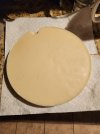-
The SH Membership has gone live. Only SH Members have access to post in the classifieds. All members can view the classifieds. Starting in 2020 only SH Members will be admitted to the annual hunting contest. Current members will need to follow these steps to upgrade: 1. Click on your username 2. Click on Account upgrades 3. Choose SH Member and purchase.
-
We've been working hard the past few weeks to come up with some big changes to our vendor policies to meet the changing needs of our community. Please see the new vendor rules here: Vendor Access Area Rules
You are using an out of date browser. It may not display this or other websites correctly.
You should upgrade or use an alternative browser.
You should upgrade or use an alternative browser.
Soap ??
- Thread starter frankp
- Start date
Fuse Dude
Well-Known Member
The recipe we use comes from "Simple and Natural Soap Making" by Jan Berry (pg 37). It's pretty standard "Lye soap" recipe that just uses water, tallow, and Lye. We use essential oils for scents but you can make unscented just as easily. There are plenty of other recipes online. Thesage.com has some recipes (though very few I found call for tallow) and a lye calculator. The lye calculator calculates the amount of water and Lye you need for a given quantity of fat and allows you to mix different fats in single recipe. It also gives you a good range for different variations of the same basic recipe by changing amount of Lye, which I like a lot. I don't think they have any recipes for pure tallow soap but anything with "lard" you can substitute tallow for the lard. Other fats (Olive oil, caster oil, coconut oil, etc.) can really change the texture, bubbliness, etc of a soap and are often considered "softer" on the skin. They can also help you make more soap if you don't have as much tallow.
We (Mrs and I) really like the pure tallow soap, but my oldest kid (28) likes mixing in other oils for a different feel.
For molds, you can make simple molds from wood and some wax paper or you can buy fancy silicone molds used for soap or candy/chocolate making. We have a combination of both. A "loaf" mold should be cut before it fully cures (hardens), though. A cutting wire (think piano wire strung between a frame similar to a large egg slicer) cuts well. A muffin pan will also make a suitable mold (if you don't mind circular/conical soaps) though some people worry about mixing the "raw" soap with anything used for cooking food due to the lye.
EDIT: Forgot to mention.. render your tallow a few times to really get all the impurities out. I do it in a crock pot with a lot of water and add some salt to help pull out the impurities and separate the fat more "cleanly". Our tallow starts off almost white to a pale "cream" color when it's ready for soap making. The picture below shows a block that came out of our crock pot and the color still looks a bit yellow. We've found it loses some color over time but it's not particularly relevant. I will say it can sometimes really stink when rendering. A lot of the "homesteading" or "natural" websites tell you to do it outside. I've never felt the need and we use the same crockpot we cook in to render our tallow. (It's just cooking the fat out of the meat which is all we do when we cook food anyway.) This block is about an inch thick and weighs 31 1/2 ounces. That makes just about 2 pounds of soap (pretty close to 1:1 tallow to soap weight.)

We (Mrs and I) really like the pure tallow soap, but my oldest kid (28) likes mixing in other oils for a different feel.
For molds, you can make simple molds from wood and some wax paper or you can buy fancy silicone molds used for soap or candy/chocolate making. We have a combination of both. A "loaf" mold should be cut before it fully cures (hardens), though. A cutting wire (think piano wire strung between a frame similar to a large egg slicer) cuts well. A muffin pan will also make a suitable mold (if you don't mind circular/conical soaps) though some people worry about mixing the "raw" soap with anything used for cooking food due to the lye.
EDIT: Forgot to mention.. render your tallow a few times to really get all the impurities out. I do it in a crock pot with a lot of water and add some salt to help pull out the impurities and separate the fat more "cleanly". Our tallow starts off almost white to a pale "cream" color when it's ready for soap making. The picture below shows a block that came out of our crock pot and the color still looks a bit yellow. We've found it loses some color over time but it's not particularly relevant. I will say it can sometimes really stink when rendering. A lot of the "homesteading" or "natural" websites tell you to do it outside. I've never felt the need and we use the same crockpot we cook in to render our tallow. (It's just cooking the fat out of the meat which is all we do when we cook food anyway.) This block is about an inch thick and weighs 31 1/2 ounces. That makes just about 2 pounds of soap (pretty close to 1:1 tallow to soap weight.)

Last edited:
I've never studied soap making but interested. Can you buy scents to add to it ?The recipe we use comes from "Simple and Natural Soap Making" by Jan Berry (pg 37). It's pretty standard "Lye soap" recipe that just uses water, tallow, and Lye. We use essential oils for scents but you can make unscented just as easily. There are plenty of other recipes online. Thesage.com has some recipes (though very few I found call for tallow) and a lye calculator. The lye calculator calculates the amount of water and Lye you need for a given quantity of fat and allows you to mix different fats in single recipe. It also gives you a good range for different variations of the same basic recipe by changing amount of Lye, which I like a lot. I don't think they have any recipes for pure tallow soap but anything with "lard" you can substitute tallow for the lard. Other fats (Olive oil, caster oil, coconut oil, etc.) can really change the texture, bubbliness, etc of a soap and are often considered "softer" on the skin. They can also help you make more soap if you don't have as much tallow.
We (Mrs and I) really like the pure tallow soap, but my oldest kid (28) likes mixing in other oils for a different feel.
For molds, you can make simple molds from wood and some wax paper or you can buy fancy silicone molds used for soap or candy/chocolate making. We have a combination of both. A "loaf" mold should be cut before it fully cures (hardens), though. A cutting wire (think piano wire strung between a frame similar to a large egg slicer) cuts well. A muffin pan will also make a suitable mold (if you don't mind circular/conical soaps) though some people worry about mixing the "raw" soap with anything used for cooking food due to the lye.
EDIT: Forgot to mention.. render your tallow a few times to really get all the impurities out. I do it in a crock pot with a lot of water and add some salt to help pull out the impurities and separate the fat more "cleanly". Our tallow starts off almost white to a pale "cream" color when it's ready for soap making. The picture below shows a block that came out of our crock pot and the color still looks a bit yellow. We've found it loses some color over time but it's not particularly relevant. I will say it can sometimes really stink when rendering. A lot of the "homesteading" or "natural" websites tell you to do it outside. I've never felt the need and we use the same crockpot we cook in to render our tallow. (It's just cooking the fat out of the meat which is all we do when we cook food anyway.) This block is about an inch thick and weighs 31 1/2 ounces. That makes just about 2 pounds of soap (pretty close to 1:1 tallow to soap weight.)
View attachment 96854
- Joined
- Jan 5, 2021
- Messages
- 2,167
Awesome thread - thanks for sharing!
Yes, pretty much any "essential oil" can be added for scents. Basically, you add them in when you've reached "trace" (the point where the soap is fully mixed and ready for putting in the mold.)I've never studied soap making but interested. Can you buy scents to add to it ?
A lot of the recipes you'll find will also have recommendations for scents. Citrus oils supposedly "fade quickly" and lose their scent but the one we made with Orange Oil lasted at least a year in the box we stored the soap in so that seems not too bad to me. That said, our other soaps clearly kept their scent "strong" for longer.
The website I mentioned in my last post sells essential oils but you can find them in a lot of different places. A google search will present you with nearly limitless options for what and where to buy. We've bought them from amazon, soap making supply places, "natural" shops, farmers markets, etc. I've even tried to make some but it was way more trouble than it was worth (in my opinion) so not planning to do that again.
I did a batch of soap once and added sagebrush seeds. It had a good sage scent, and was exfoliating. I made it for hunting originally, but used it all the time. It’s about time to collect more seeds for another batch .
Finally cooked up our latest batch and split it into several small batches. Mixed up some "espresso" with coffee grounds (the grounds help with exfoliation). A 50/50 mix with tee tree and bergamot, a 50/50 mix of lavender and lemongrass, and one with 70/30 lemon oil and mandarin orange. In total about 3.25 pounds worth of soap.


